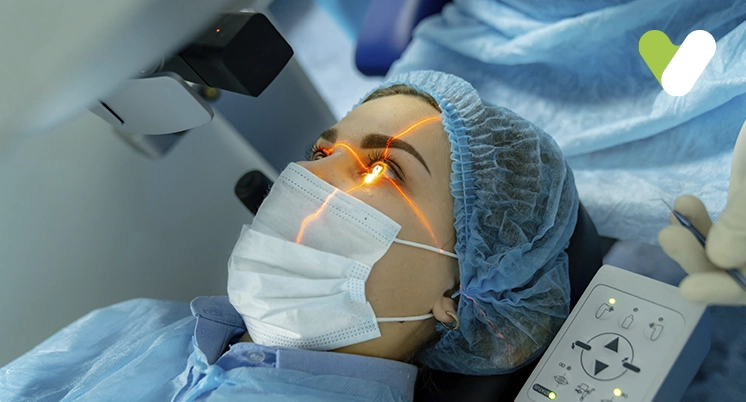A cataract eye surgery is a fairly routine procedure performed to remove the cloudy lens from a person’s eye and replace it with an artificial lens. Cataract is a common condition of the eye that causes the lens to become cloudy leading to problems with their vision. The only treatment method for this condition is cataract surgery.
The chances of a person getting cataract increase with age; thus, many elderly patients have either had a cataract surgery or have to schedule for one. Upon noticing blurry vision, the person visits an eye doctor (or ophthalmologist) for a check-up. The doctor performs physical examination and confirms the diagnosis, after which a cataract surgery is scheduled for a convenient date for the patient.
Is cataract surgery necessary?
The lens in the eye is clear and used to refract or bend light coming in and project it to the retina. The eye lens can be considered a gateway for the light to pass in order for the brain to process the light and see. If this lens becomes cloudy, light cannot pass through it efficiently; similar to the gateway being clogged. Visuals from the eye with cataract resemble those from a dusty or foggy window.
This cloudy lens cannot be repaired, and the only way to treat cataract is to remove the foggy lens through a cataract operation. An ophthalmologist will recommend the patient to undergo a cataract surgery at a time when the patient is less likely to sweat or cry, reducing the chances of any infection in the eye.
The doctor will recommend the patient to undergo cataract surgery when they are not able to see clearly or have:
- trouble doing their work or other chores,
- increased likelihood of an accident,
- developed an inability to read or watch television,
- developed dependence on someone else to get around.
A cataract does not pose any other risk to overall health except increasing the chances of an accident, so waiting a while for getting the surgery usually does no harm in most cases. Cataract eye surgery is also ordered when cataract in your eye is preventing the treatment of another underlying condition.
Cataract surgery procedure
On the day of the surgery, your doctor will ask you to stop eating anything solid a minimum of 6 hours before the procedure to prevent any complications with the anaesthesia. The cataract operation is an outpatient procedure, so most likely you will be discharged on the same day.
Before taking the patient in the operation theatre, the doctor or nurses will start preparing the patient’s eye for the surgery. They may you numbing drops or inject the numbing medicine around the eye. The patient will be conscious during the procedure and may notice light and movement through the eye under operation.
Using a special microscope, the surgeon will perform the surgery. They will start by making tiny cuts or incisions near the edge of the cornea (the white part of the eye). These incisions provide the surgeon access to the lens. All the instruments used in a cataract surgery are very small. The surgeon then breaks up the affected lens and removes it. They will then put a new lens in place. To study the eye and determine the proper focusing power for the intraocular lens (IOL) to be implanted, the surgeon will call you in for a consultation before the surgery.
The surgeon usually does not need to stitch the cut as it seals itself. However, they will place a shield over your eye to protect it from any damage and allow time for healing. After the surgery, the patient will be kept under observation for about 15–30 minutes and sent home.
Laser cataract surgery is a slightly advanced version of a cataract eye surgery that uses laser to make the incisions instead of a blade, giving the surgeon more precision.
Types of the lens used for cataract surgery
An intraocular lens is used to replace the original lens in the affected eye. An IOL is a flexible artificial lens that is implanted in the eye through a small incision. The IOL comes with different focusing powers according to each patient’s individual needs. If the right match is selected, people with bad eyesight may not need to wear glasses or spectacles after the surgery. Depending on the focal powers there are different types of IOLs, including the following:
- Monofocal IOLs These types of lens are measured for short-, medium-, or long-range vision. Many people, who have troubles with their long- and short-range vision, choose to get lenses for distance vision and wear reading glasses later on for close vision.
- Multifocal IOLs These lenses allow people to have better long- and short-range vision without opting for additional glasses.
- Accommodative IOLs These are special lenses that closely resemble the natural lens of the eye and allow the patient to focus at different distances.
- Toric IOLs People who have astigmatism can also choose a toric IOL for their eye during the cataract surgery.
One can discuss the type of IOL they need with their doctor before the surgery. The patient may also want to check this their insurance provider (if you have any) as this will also impact cataract operation costs.
Post-surgery care and recovery
Cataract surgery is an outpatient procedure that does not last more than a few hours, and the patient will go home the same day. The eye shield or dressing from the surgery can be removed the next day with the doctor’s approval, but the patient will need to wear protective eyeglasses and use special eye drops to help with the recovery process. After a few days of the surgery, the patient will notice that their vision starts to clear up slowly; the eyedrops will continue for about four weeks.
Some of the temporary common side effects observed after the surgery listed here:
- Double or blurred vision
- Gritty or gravelly feeling in your eye
- Red eyes
- Watery eyes
The patient can also notice the colours seem brighter and renewed clarity in their vision after the surgery. The doctor will ask the patient to come in for check-up in couple of days right after the surgery, then after a week, and then after a month.
Risks and complications
Although it generally is a safe procedure, a cataract surgery has some risks, such as damage to other parts of the rare, dislocated IOL implant, but such this is rare. If any of the following symptoms are noticed, the patient should visit their doctor immediately.
- Vision loss
- Persistent pain despite taking pain reliever medicines
- Increased redness in the eye
- Swelling in the eyelid
- Light flashes or spots in front of the eye
Some patients may get eye infections after the surgery, but it is treatable and usually does not cause much damage if one visits the doctor on time.
What is posterior capsular opacification?
People who have undergone cataract surgery may develop blurred or clouded vision after the surgery. This can happen a week, month, or years after the surgery and is not unusual. Posterior capsular opacification or PCO occurs when the membrane holding the IOL in place becomes cloudy. In simple terms, this membrane (posterior capsule) is like a transparent pocket holding the lens (the natural and the IOL), which becomes cloudy in the case of PCO. It is important to note that the IOL remains fine in this scenario.
PCO is also referred to as secondary cataract sometimes. One may need to have a laser procedure—posterior capsulotomy—to treat this condition and restore clear vision. During this procedure, the doctor uses a laser to create a small opening in the clouded capsule that clears the passage for light. Posterior capsulotomy, also called yttrium-aluminium-garnet (YAG) laser capsulotomy, is essentially an outpatient procedure that takes about 5 minutes.
The doctor will monitor the patient for about an hour in their clinic or the hospital before the patient is allowed go home. In some cases, people may have increased eye pressure and retinal detachment, but it is rare.
Cataract surgery cost in India
Cataract operation costs depends on the various factors, including the following:- Location or city
- Laser surgery or normal surgery
- Type of lens chosen
- Expertise of the doctor
- Additional services provided by the hospital
Most insurance companies provide coverage for cataract surgery. However, it is better to talk to the insurance provider before going in for the surgery as they may not cover special lenses. Although the cost cataract surgery is usually covered, the patient may still have to incur some costs. Having an early cataract surgery, that is, before vision deteriorates to a certain degree, may cost a person a little more.
Outlook for patients
Cataract surgery is an essential process for people with the condition to restore their vision and lead a healthy life. Although cataract does not cause additional health problems, it increases the risk of accidents and prevents the effective treatment of certain diseases. People with cataract usually do not require any further treatment for their condition. However, sometimes the remaining part of the lens and its pouch can become cloudy; this condition is known as PCO and can be treated in about 5 minutes in an outpatient procedure.
The recovery time after a cataract surgery usually is about a week or two. During this time period, the patient will likely have to wear a protective shield on their eye and have to use eyedrops. People who have had eye problems before the cataract surgery can also choose a special IOL implant for the eyes and avoid wearing glasses.


